It’s probably an issue with demand with building dedicated bike lanes in the industrial areas. Although I can’t see why the sidewalks can’t be widened and made a shared ROW as a standard in new industrial areas
Industrial areas are such low density, it's really hard to service them effectively. A lot of industrial areas are in the ~3000 jobs per sq km range; as a comparison, if you built 1.6 km of cycle facilities connecting Barlow and 52nd St SE, there would be roughly 5000 employees of the buildings vaguely near the path, within one block (using one large industrial block as the measure).
One block around the 3rd Ave cycle track, for instance the block across from Livingston Place, would service 10,000 workers (and the 300 or so apartments in the International hotel conversion), and that's using the much smaller downtown blocks and not picking the densest block of the track. And with 1/10 the cycle track amount; these figures are roughly the same scale. That's a 20x return on investment (assuming the same cost per metre of cycle facility, which is probably not true.)
I think that the best approach for industrial areas is:
1). New areas should get pathways built as standard. The cost of a sidewalk on one side and a pathway on the other side of the street is pocket change in the cost of building a new road in an industrial area, and it should always be done. I was in some new industrial land in the NE this summer, and this is being done there; good job! This is looking at the intersection of Barlow and Country Hills NE from the northwest; the pathways (ie nine foot wide pieces of asphalt) are highlighted in yellow. There's no point in making future problems for ourselves. But note also that this is still an industrial area, so there are a lot of driveways, big sweeping corners and so on -- it's still not as cycle friendly as other areas.
2). Sidewalk refit / retrofit programs, to the degree they happen, should upgrade to a multiuse path on at least one side of the street whenever possible. If we're adding in sidewalks, may as well add in bike connectivity.
3). Consider adding key pathways in industrial areas where it makes the most sense. These are areas that have:
- higher densities of jobs (for highest benefit)
- higher numbers of residents within 2-5 km (reasonable cycling range)
- non-industrial uses, such as commercial areas (so that shoppers can also cycle)
- connectivity to the main city-wide pathway network (to enable longer-distance cycling for those who might do it).
The two main areas that fit this are the Manchester area / central industrial area west of Blackfoot, and the Franklin/Meridian/Sunridge area in the northeast industrial area east of Barlow. There is a semi-reasonable pathway through the NE industrial area that connects from Rundle LRT to the Nose Creek pathway running just north of 16th Ave and then curving through Vista Heights; the 42nd Ave S upgrades connect to the Elbow pathway. Also notable is that both areas have or are near to significant regional facilities that could also be destinations for cyclists; Chinook Centre and Sunridge/Lougheed Hospital.
I've posted before this crayon design for the Manchester area, where existing/new pathways are in green/cyan, existing/new cycle tracks are in yellow/orange and existing/new sidewalk/path retrofits are in magenta/pink:
A back-of-the-envelope costing was $10M for the new facilities in residential areas and $22M in the industrial areas; about the same linear amount, but sidewalk/path construction is much more expensive per meter than cycle tracks, since there's more actual construction work involved. There's roughly 25000 jobs in the industrial area here (not including Chinook), or 2.5x the number of jobs adjacent to the one block of downtown cycle track I showed above. I think this also highlights the importance of not just building in industrial areas, but also the adjacent communities.






